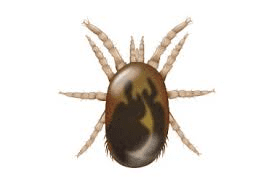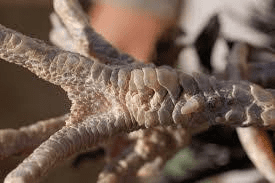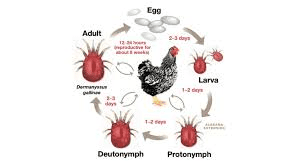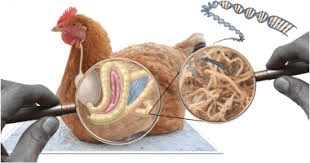Poultry parasites obtain their food from either the skin or feathers of living birds and they draw blood with the aid of the hook on the head. Various parasites like lice, mites and ticks are common in poultry.
(1) Lice
Parasites like lice are commonly found among birds of various types. The largest out of more than 30 species of lice do not measure more than 1/3inch long and with this size, they can move very fast on the skin of host birds.
With a pair of lice, more than 10,000 can be produced within a short period of time and their life cycle can be completed within 2-4 weeks firmly clicked to the host’s skin or feathers.
The poultry louse is wingless, skin colored, and has six legs. There are several species that may be found on chickens, turkeys, ducks, and other fowl. When eggs are laid, they attach to the host’s feathers.
The generation time is from two to seven weeks depending on the species. The entire life cycle of the louse is spent on the host unless by chance the insect is disturbed and happens to be found on a human or other animal.
Lice generally feed on skin particles and feathers, but do not have sucking mouthparts and do not feed on blood. When examining a bird for lice they are usually found on the skin around the vent and under the wings.
Many different types of lice live on poultry and remain on the bird throughout their entire life. Eggs (nits) are laid in clusters at the base of the feather shaft and hatch in 4-7 days. An adult louse will live for about 3 weeks, laying between 50-300 eggs.
(2) Mites
Mites are extremely small and not visible to the eyes. Several kinds of mites suck blood, cause irritations, promote growth of scar tissue, feather loss and even possibly internal damage. There is evidence that mites carry infectious diseases.
Mites feed on chickens during the night and then hide in cracks, under perches and nest boxes during the day. The life cycle of the mite from egg to adult is 7 days.
Read Also: 6 Ways to Enhance Egg Production and Maximize Profits on Poultry Layers
There are several species of mites that may be found on poultry. This insect can be spread from farm to farm by infested crates, chickens, or other birds.
(2a) Common mites
Common or Red mite is a specie that does not remain on the host at all times. During the day, this mite finds refuge in cracks and crevices of nests, roosts, and other places in the poultry house.
At night the mites leave their hiding places, find a bird to provide a blood meal, and then head back into hiding. This parasite may go undetected unless the birds are examined during the night.
If a flock seems lethargic, the birds are droopy and weak, or they have pale combs and wattles, mites may be the problem. The birds themselves do not need treatment. Instead a thorough cleaning and insecticide treatment of the house are recommended.
(2b) Northern Fowl Mite

The Northern Fowl Mite is quite different in that it lives on the birds at all times. This specie of mite is usually found on the feathers around the vent. Large infestations on a bird can make the feathers appear almost black because of the eggs and excrement.
Mites can easily be spread from bird to bird and the numbers of insects on a single bird can increase rapidly. Growth rate and egg production can be reduced because of mite infestations.
As the number of mites increases the birds can appear pale, droopy, become anemic, and the mortality rate can increase. The Northern Fowl Mite is usually a cool weather pest, but can cause problems year round.
The mites can live from several days to 3 weeks detached from the host. Because of this, depopulating a house to get rid of the mite problem should include a down time of at least a month.
(2c) Depluming Mite
Another specie of mites that can cause problems is the Depluming or Feather Mite. Contrary to some reports this mite does not chew on the feather and make them fall out.
Instead, the mite burrows into the skin at the base of the feather and irritates it, so the bird pulls the feather out in an attempt to eliminate the irritation.
(2d) Scaly Leg Mite

This specie lives under the scales on the legs and feet of birds. Because it lives under the scales, the mite causes itching and irritation, also causing the scales to appear pushed up or thicker. Sometimes a crusty appearance can be seen on the feet and legs.
Older birds seem to be more likely candidates for this insect. Many years ago, producers treated birds with these characteristics by standing them in a container of kerosene for a few minutes. The kerosene seemed to do two things.
First, it had enough oil in it to seal off the air and the insects would not survive and secondly, the oil also helped soften the crusty scales, so they could be eliminated and replaced.
An alternative to kerosene is baby oil or something similar that acts in the same manner. The legs and feet can also be treated with an approved insecticide, and then rubbed with oil.
Read Also: Daily Poultry Feed Requirements for each Stage
(2e) Chiggers
The chiggers that cause problems with poultry are the same ones that cause similar problems with people. It is a specie of mite that is non-specific to a host.
The irritations, whelps, and inflammations are the result of the insect attaching itself to the skin. If birds have multiple lesions they may become irritable, droopy, and will not eat.
If birds are to be slaughtered the lesions will result in downgrades or condemnations. Chiggers are normally found on grass and weeds and may be a problem if birds are allowed to range in areas with tall vegetation.
Chigger problems can be reduced if the vegetation is sprayed with an approved insecticide. Malathion dust or spray is an example. With any insecticide the label directions on mixing, application, and restrictions should always be followed.
(3) Ticks
Ticks are uncommon problem but sometimes occur in warm and dry climates. They cause loss of blood, low egg production and carriers of several germs. Ticks bite may cause paralysis of legs and wings.
It is easy to recognize being about 1/3 – 1/4inch long, having a flat egg shaped body and reddish brown color. Young birds suffer greatest damage from ticks.
Read Also: Comprehensive Guide on How to start Cockerel Farming Business
Symptoms of Mites and Lice

Mites
- Skin irritation and restlessness in birds
- Darkened or dirty feather appearance
- Drop in egg production
- Pale comb and wattle
- Anaemia
- Visual – scabs or mites present around the vent, the breast, under wings and scaly legs
- Large numbers can cause deaths
Lice
- Feather damage and loss due to itching and irritation
- Dull appearance
- Often found around the vent area
- Mass of lice eggs at the base of the feather shaft
Impacts on Chickens / Poultry Birds
Mites
Red mite may transmit other poultry diseases such as fowl cholera. The skin irritation of birds may also possibly lead to feather pecking. In severe mite infestations, egg production is reduced and birds will suffer from anaemia.
Lice
Skin irritations caused by heavy infestations of lice may be the source of secondary infections.
How it is spread
External parasites are mostly spread by bird to bird contact. Wild birds and rodents may also be responsible for parasites entering the flock. Once detected, it is highly likely that all birds and housing are infected.
Read Also: Cold Weather Poultry Diseases and How to Manage them
Preventive Measures of Poultry External Parasites

External parasites can cause real problems for small flock poultry producers and occasionally for large flock producers. The lice and mites are host specific and are not found on animals other than birds.
External parasites can be prevented or controlled by mixing 4 teaspoon of Marathon insecticide or Vetox 85 insecticide into a bucket of water, sink each bird inside the bucket containing the mixed water excluding the head. You can use any other insecticide for this exercise.
After completing this exercise, you must maintain strict sanitary measures for the benefit of the birds and poultry farmers themselves.
The old saying “an ounce of prevention is worth a pound of cure” applies here. If keeping an infestation from getting started can prevent insect problems, it is by far better than attempting a control.
Eliminating wild birds from the poultry house is a good place to start. This can be done by repairing any holes in the roof or sides of the house that birds might use as entry points.
Preventing feed spills and not feeding chickens outside the poultry house will also discourage wild birds from remaining in the area. If wild birds start to build nests in or around the poultry house, the nesting materials should be removed immediately.
Artificial snakes and owls can be placed in or around the poultry house as an additional means of discouraging wild birds. Another important preventive measure is to be sure all equipment and new birds coming into a flock are free of lice and mites.
Some small poultry producers provide a container of sand where the birds can dust themselves. In addition to the sand, a powdered insecticide such as Sevin can be mixed in the container, and while the birds dust themselves they are applying the insecticide to keep down infestations.
Read Also: Predators, Parasites and Diseases of Snail
Treating Lice and Mites
Lice are not usually an issue in commercial flocks, but may show up in small flock situations. Mites on the other hand may be a problem in all sizes of production.
As mentioned previously, a good isolation and sanitation program can help prevent problems with external parasites. If external parasites are detected in the flock there are several chemical treatment options available.
Chemical controls for treating houses, nests, roosts, etc include malathion, carbaryl (Sevin), coumaphos (Co-Ral), and Rabon. If common mites are suspected, careful treatment of cracks and crevices is a must and a repeat treatment may be necessary.
If direct treatment of the birds is necessary, such materials as malathion, carbaryl, Rabon (all three are available in either the dust or spray form), coumaphos, and permethrin (trade names include Atroban, Eciban, Purina Hard Hitter, Insectrin, Overtime, Permectrin) can be used.
For all chemicals used for poultry, the label directions for mixing, application, and precautions should always be carefully followed.
Read Also: How to Generate Money from Animal By-Products
Frequently Asked Questions
We will update this section soon.

